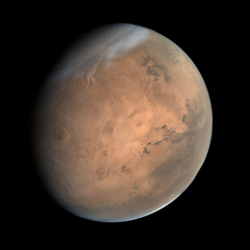Desert planet
Topic: Astronomy
 From HandWiki - Reading time: 4 min
From HandWiki - Reading time: 4 min
A desert planet, also known as a dry planet, an arid planet, or a dune planet, is a type of terrestrial planet with a surface consistency similar to Earth's hot deserts. Mars is arguably the only present example of a desert planet.[1]
History
A 2011 study suggested that not only are life-sustaining desert planets possible, but that they might be more common than Earth-like planets.[2] The study found that, when modeled, desert planets had a much larger habitable zone than ocean planets.[2] The same study also speculated that Venus may have once been a habitable desert planet as recently as 1 billion years ago.[2] It is also predicted that Earth will become a desert planet within a billion years due to the Sun's increasing luminosity.[2]
A study conducted in 2013 concluded that hot desert planets without runaway greenhouse effect can exist in 0.5 AU around Sun-like stars. In that study, it was concluded that a minimum humidity of 1% is needed to wash off carbon dioxide from the atmosphere, but too much water can act as a greenhouse gas itself. Higher atmospheric pressures increase the range in which the water can remain liquid.[3]
Science fiction
The concept has become a common setting in science fiction,[4] appearing as early as the 1956 film Forbidden Planet and Frank Herbert's 1965 novel Dune.[5][6][7] The environment of the desert planet Arrakis (also known as Dune) in the Dune franchise drew inspiration from the Middle East, particularly the Arabian Peninsula and Persian Gulf, as well as Mexico.[8] Dune in turn inspired the desert planets which prominently appear in the Star Wars franchise,[9] including the planets Tatooine, Geonosis, and Jakku.
See also
References
- ↑ "Mars". https://solarsystem.nasa.gov/planets/mars/overview.
- ↑ 2.0 2.1 2.2 2.3 Choi, Charles Q. (September 2, 2011). "Alien Life More Likely on Dune Planets". Astrobiology Magazine. http://www.astrobio.net/news-exclusive/alien-life-more-likely-on-dune-planets/.
- ↑ Andras Zsom; Sara Seager; Julien de Wit; Vlada Stamenkovic (September 4, 2013). "Towards the Minimum Inner Edge Distance of the Habitable Zone". The Astrophysical Journal 778 (2): 109. doi:10.1088/0004-637X/778/2/109. Bibcode: 2013ApJ...778..109Z.
- ↑ Touponce, William F. (1988). "Intellectual Background". Frank Herbert. Boston: Twayne Publishers imprint, G. K. Hall & Co. p. 119. ISBN 978-0-8057-7514-3.
- ↑ Wright, Les. "Forbidden Planet (1956)". Culturevulture.net (Internet Archive). http://www.culturevulture.net/Movies4/ForbiddenPlanet.htm.
- ↑ Hladik, Tamara I.. "Classic Sci-Fi Reviews: Dune". SciFi.com. http://www.scifi.com/sfw/issue42/classic.html.
- ↑ Michaud, Jon (July 12, 2013). "Dune Endures". The New Yorker. http://www.newyorker.com/online/blogs/books/2013/07/dune-endures.html. Retrieved November 27, 2013.
- ↑ Lynch, Tom; Glotfelty, Cheryll; Armbruster, Karla (2012). The Bioregional Imagination: Literature, Ecology, and Place. University of Georgia Press. p. 230. ISBN 9780820343679. https://books.google.com/books?id=flt4Uea3oOcC&pg=PA230.
- ↑ "Star Wars is Dune". D. A. Houdek. http://www.dahoudek.com/pages/starwarsdune.htm.
 |
29 views | Status: cached on July 27 2024 05:29:49
↧ Download this article as ZWI file
 KSF
KSF



